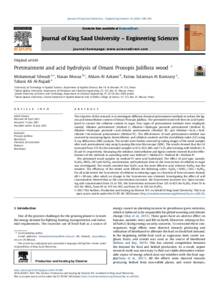وثيقة
Pretreatment and acid hydrolysis of Omani prosopis juliflora wood.
المعرف
DOI: 10.1016/j.jksues.2021.07.003
المصدر
Journal of King Saud University - Engineering Sciences. v. 35, 6, p. 359-365
المساهمون
Mousa, Hasan., مؤلف
Al-Azkawiyah, Ahlam., مؤلف
الدولة
Saudi Arabia.
مكان النشر
Riyadh
الناشر
King Saud University.
ميلادي
2021-09-01
اللغة
الأنجليزية
الموضوع
الملخص الإنجليزي
The objective of this research is to investigate different chemical pretreatment methods to reduce the lignin and hemicellulose content of Omani Prosopis Juliflora. The pretreated wood will then be acid hydrolyzed to convert the cellulose content to sugar. Four types of pretreatment methods were employed, namely: Alkaline pretreatment (Method I), Alkaline + Hydrogen peroxide pretreatment (Method II), Alkaline + Hydrogen peroxide + acid-chlorite pretreatment (Method III) and Alkaline + H2O2 + Acid-chlorite + bicarbonate pretreatment (Method IV). The effectiveness of each pretreatment method was assessed by measuring lignin, hemicellulose, and cellulose contents and the crystallinity index (CrI) using X-ray diffraction (XRD) analysis. The results were further assessed by taking images of the wood samples after each pretreatment step using Scanning Electron Microscope (SEM). The results showed that the CrI increased from 51% for the untreated samples to 61%, 65%, 68% and 73.2% after treating with Method I, II, III and IV, respectively. Measuring the cellulose, hemicellulose and lignin contents showed that the effectiveness of the methods in ascending order was Method I Method II Method III Method IV. The pretreated wood samples by method IV were acid hydrolyzed. The effect of acid type, namely: H2SO4, HNO3, HCl and H3PO 4, concentration and hydrolysis time on the %conversion of cellulose to sugar was investigated. The results revealed that H2SO4 was the most effective acid, whereas H3PO 4 was the weakest. The efficiency of the tested acids follows the following order: H2SO4 > HNO3 > HCL > H3PO 4. For all acids tested, the %conversion of cellulose to reducing sugar as a function of time increases linearly till t = 90 min, after which no change in the %conversion was obtained. Investigating the effect of acid concentration showed that as the concentration increases, the %conversion increases too. Upon increasing acid concentration from 1% to 10%, the %conversion increases from 12% to 62% for H2SO4, from 5% to 43% for HNO3, from 0% to 47% for HCl, and from 5% to 34% for H3PO4.
ISSN
1018-3639
قالب العنصر
مقالات الدوريات

